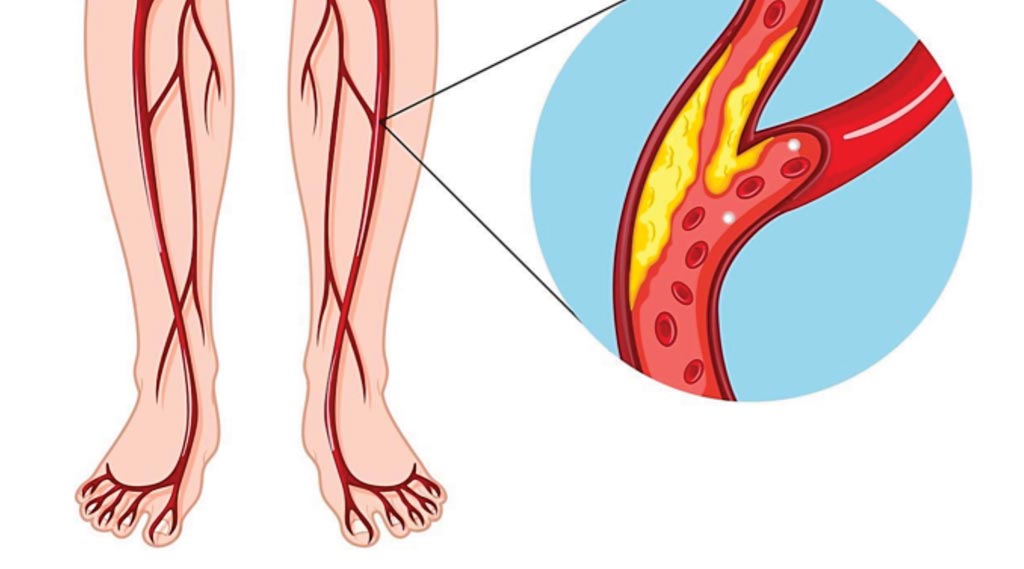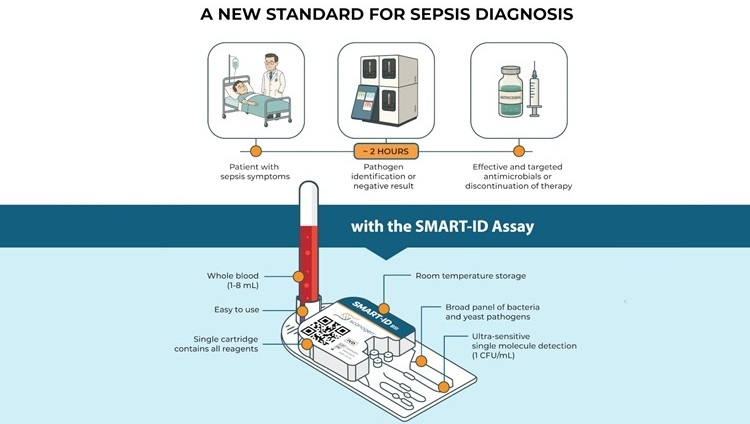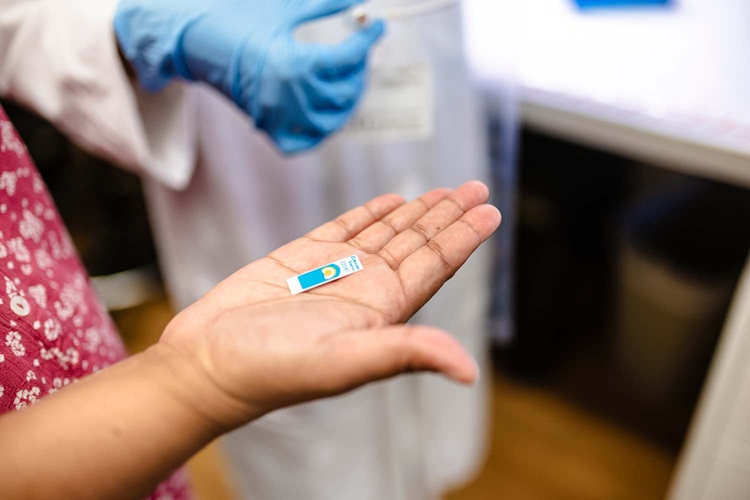GWAS Links Novel Loci to Peripheral Artery Disease Risk
|
By LabMedica International staff writers Posted on 25 Jul 2019 |

Image: A diagram illustrating peripheral artery disease in the lower limbs (Photo courtesy of US National Institute of Health).
Peripheral artery disease (also called peripheral arterial disease, PAD)) is a common circulatory problem in which narrowed arteries reduce blood flow to the limbs. PAD most commonly affects arteries in the legs. Both PAD and coronary artery disease (CAD) are caused by atherosclerosis.
The classic symptom of PAD is leg pain when walking which resolves with rest, known as intermittent claudication. Other symptoms include skin ulcers, bluish skin, cold skin, or abnormal nail and hair growth in the affected leg. Complications may include an infection or tissue death which may require amputation; coronary artery disease, or stroke and up to 50% of people with PAD do not have symptoms.
A team of scientists working with the Corporal Michael J. Crescenz VA Medical Center (Philadelphia, PA, USA) in their two-phase genome-wide association study (GWAS), they first conducted separate discovery analyses in 24,009 white veterans with PAD, 5,373 black veterans with PAD, and 1,925 Hispanic veterans with PAD before combining them into a meta-analysis. All the cases had a median minimum ankle-brachial index, a measure of blood flow to the limbs, of less than 0.9, while the 211,753 controls had a median minimum ankle–brachial index (mABI) of about 1.
The team identified 18 novel loci associated with peripheral artery disease. A number of these loci have also been implicated in other vascular conditions, suggesting that certain existing treatment approaches might have broader applicability. Other variants, like one linked to clotting, were PAD-specific. They also conducted a phenome-wide association study to examine whether any of these 19 lead single-nucleotide polymorphisms (SNPs) were also linked to other disease phenotypes. Of the 1,101 disease phenotypes queried, they found ties to known risk factors for PAD, such as type 2 diabetes, hypercholesterolemia, and hypertriglyceridemia, as well as to smoking.
Four risk variants appear to be PAD specific. One of these is the factor V Leiden gene mutation, F5 p.R506Q, which is a leading cause of inherited thrombophilia, a clotting disorder. When they further tested the relationship between factor V Leiden and increasing PAD severity, as indicated by rest pain, tissue loss, or amputation, they found significant associations with PAD subtypes. Carriers of the mutation, for instance, had a 62% increased risk of a PAD-linked amputation.
The authors suggested that suggested treatments targeting the coagulation cascade could also work for PAD; something they noted is supported by the recent COMPASS trial, which found that adding low-dose rivaroxaban, an inhibitor of factor Xa, to aspirin treatment prevented major adverse limb events. Their results highlight mechanistic similarities and differences among coronary, cerebral, and peripheral atherosclerosis and provide therapeutic insights. The study was published on July 8, 2019, in the journal Nature Medicine.
Related Links:
Corporal Michael J. Crescenz VA Medical Center
The classic symptom of PAD is leg pain when walking which resolves with rest, known as intermittent claudication. Other symptoms include skin ulcers, bluish skin, cold skin, or abnormal nail and hair growth in the affected leg. Complications may include an infection or tissue death which may require amputation; coronary artery disease, or stroke and up to 50% of people with PAD do not have symptoms.
A team of scientists working with the Corporal Michael J. Crescenz VA Medical Center (Philadelphia, PA, USA) in their two-phase genome-wide association study (GWAS), they first conducted separate discovery analyses in 24,009 white veterans with PAD, 5,373 black veterans with PAD, and 1,925 Hispanic veterans with PAD before combining them into a meta-analysis. All the cases had a median minimum ankle-brachial index, a measure of blood flow to the limbs, of less than 0.9, while the 211,753 controls had a median minimum ankle–brachial index (mABI) of about 1.
The team identified 18 novel loci associated with peripheral artery disease. A number of these loci have also been implicated in other vascular conditions, suggesting that certain existing treatment approaches might have broader applicability. Other variants, like one linked to clotting, were PAD-specific. They also conducted a phenome-wide association study to examine whether any of these 19 lead single-nucleotide polymorphisms (SNPs) were also linked to other disease phenotypes. Of the 1,101 disease phenotypes queried, they found ties to known risk factors for PAD, such as type 2 diabetes, hypercholesterolemia, and hypertriglyceridemia, as well as to smoking.
Four risk variants appear to be PAD specific. One of these is the factor V Leiden gene mutation, F5 p.R506Q, which is a leading cause of inherited thrombophilia, a clotting disorder. When they further tested the relationship between factor V Leiden and increasing PAD severity, as indicated by rest pain, tissue loss, or amputation, they found significant associations with PAD subtypes. Carriers of the mutation, for instance, had a 62% increased risk of a PAD-linked amputation.
The authors suggested that suggested treatments targeting the coagulation cascade could also work for PAD; something they noted is supported by the recent COMPASS trial, which found that adding low-dose rivaroxaban, an inhibitor of factor Xa, to aspirin treatment prevented major adverse limb events. Their results highlight mechanistic similarities and differences among coronary, cerebral, and peripheral atherosclerosis and provide therapeutic insights. The study was published on July 8, 2019, in the journal Nature Medicine.
Related Links:
Corporal Michael J. Crescenz VA Medical Center
Latest Pathology News
- Rapid Low-Cost Tests Can Prevent Child Deaths from Contaminated Medicinal Syrups
- Tumor Signals in Saliva and Blood Enable Non-Invasive Monitoring of Head and Neck Cancer
- Common Health Issues Can Influence New Blood Tests for Alzheimer’s Disease
- Blood Test Formula Identifies Chronic Liver Disease Patients with Higher Cancer Risk
- Tunable Cell-Sorting Device Holds Potential for Multiple Biomedical Applications
- AI Tool Outperforms Doctors in Spotting Blood Cell Abnormalities
- AI Tool Rapidly Analyzes Complex Cancer Images for Personalized Treatment
- Diagnostic Technology Performs Rapid Biofluid Analysis Using Single Droplet
- Novel Technology Tracks Hidden Cancer Cells Faster
- AI Tool Improves Breast Cancer Detection
- AI Tool Predicts Treatment Success in Rectal Cancer Patients
- Blood Test and Sputum Analysis Predict Acute COPD Exacerbation
- AI Tool to Transform Skin Cancer Detection with Near-Perfect Accuracy
- Unique Immune Signatures Distinguish Rare Autoimmune Condition from Multiple Sclerosis
- Simple Optical Microscopy Method Reveals Hidden Structures in Remarkable Detail
- Hydrogel-Based Technology Isolates Extracellular Vesicles for Early Disease Diagnosis
Channels
Clinical Chemistry
view channel
POC Breath Diagnostic System to Detect Pneumonia-Causing Pathogens
Pseudomonas aeruginosa is a major cause of hospital-acquired and ventilator-associated pneumonia, particularly in lung transplant recipients and patients with structural lung disease. Its ability to form... Read more
Online Tool Detects Drug Exposure Directly from Patient Samples
Doctors often rely on patient interviews and medical records to determine what medications a person has taken, but this information is frequently incomplete. People may forget drugs they used, take over-the-counter... Read moreHematology
view channel
MRD Tests Could Predict Survival in Leukemia Patients
Acute myeloid leukemia is an aggressive blood cancer that disrupts normal blood cell production and often relapses even after intensive treatment. Clinicians currently lack early, reliable markers to predict... Read more
Platelet Activity Blood Test in Middle Age Could Identify Early Alzheimer’s Risk
Early detection of Alzheimer’s disease remains one of the biggest unmet needs in neurology, particularly because the biological changes underlying the disorder begin decades before memory symptoms appear.... Read more
Microvesicles Measurement Could Detect Vascular Injury in Sickle Cell Disease Patients
Assessing disease severity in sickle cell disease (SCD) remains challenging, especially when trying to predict hemolysis, vascular injury, and risk of complications such as vaso-occlusive crises.... Read more
ADLM’s New Coagulation Testing Guidance to Improve Care for Patients on Blood Thinners
Direct oral anticoagulants (DOACs) are one of the most common types of blood thinners. Patients take them to prevent a host of complications that could arise from blood clotting, including stroke, deep... Read moreImmunology
view channelBlood Test Could Detect Adverse Immunotherapy Effects
Immune checkpoint inhibitors have transformed cancer treatment, but they can also trigger serious immune-related adverse events that damage healthy organs and may become life-threatening if not detected early.... Read more
Routine Blood Test Can Predict Who Benefits Most from CAR T-Cell Therapy
CAR T-cell therapy has transformed treatment for patients with relapsed or treatment-resistant non-Hodgkin lymphoma, but many patients eventually relapse despite an initial response. Clinicians currently... Read moreMicrobiology
view channel
Blood-Based Diagnostic Method Could Identify Pediatric LRTIs
Lower-respiratory tract infections (LRTIs) are a leading cause of illness and death worldwide, and pneumonia is the leading infectious cause of death in children under five, claiming the lives of over... Read more
Rapid Diagnostic Test Matches Gold Standard for Sepsis Detection
Sepsis kills 11 million people worldwide every year and generates massive healthcare costs. In the USA and Europe alone, sepsis accounts for USD 100 billion in annual hospitalization expenses.... Read moreRapid POC Tuberculosis Test Provides Results Within 15 Minutes
Tuberculosis remains one of the world’s deadliest infectious diseases, and reducing new cases depends on identifying individuals with latent infection before it progresses. Current diagnostic tools often... Read more
Rapid Assay Identifies Bloodstream Infection Pathogens Directly from Patient Samples
Bloodstream infections in sepsis progress quickly and demand rapid, precise diagnosis. Current blood-culture methods often take one to five days to identify the pathogen, leaving clinicians to treat blindly... Read morePathology
view channel
Rapid Low-Cost Tests Can Prevent Child Deaths from Contaminated Medicinal Syrups
Medicinal syrups contaminated with toxic chemicals have caused the deaths of hundreds of children worldwide, exposing a critical gap in how these products are tested before reaching patients.... Read more
Tumor Signals in Saliva and Blood Enable Non-Invasive Monitoring of Head and Neck Cancer
Head and neck cancers are among the most aggressive malignancies worldwide, with nearly 900,000 new cases diagnosed each year. Monitoring these cancers for recurrence or relapse typically relies on tissue... Read more
Common Health Issues Can Influence New Blood Tests for Alzheimer’s Disease
Blood-based tests for Alzheimer’s disease are transforming diagnosis by offering a simpler alternative to spinal taps and brain imaging. However, many people evaluated at memory clinics also live with... Read more
Blood Test Formula Identifies Chronic Liver Disease Patients with Higher Cancer Risk
Chronic liver disease affects millions worldwide and can progress silently to hepatocellular carcinoma (HCC), one of the deadliest cancers globally. While surveillance guidelines exist for patients with... Read moreTechnology
view channel
Machine Learning Models Diagnose ALS Earlier Through Blood Biomarkers
Amyotrophic lateral sclerosis (ALS) is a rapidly progressive neurodegenerative disease that is notoriously difficult to diagnose in its early stages. Early symptoms often overlap with other neurological... Read more
Artificial Intelligence Model Could Accelerate Rare Disease Diagnosis
Identifying which genetic variants actually cause disease remains one of the biggest challenges in genomic medicine. Each person carries tens of thousands of DNA changes, yet only a few meaningfully alter... Read moreIndustry
view channel
BD and Penn Institute Collaborate to Advance Immunotherapy through Flow Cytometry
BD (Becton, Dickinson and Company, Franklin Lakes, NJ, USA) has entered into a strategic collaboration with the Institute for Immunology and Immune Health (I3H, Philadelphia, PA, USA) at the University... Read more



















